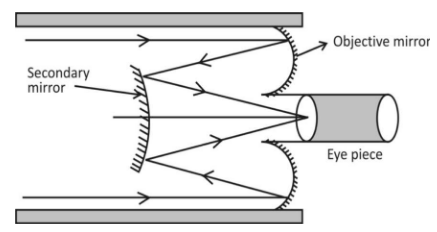
Draw a ray diagram of reflecting type telescope and hence given the advantage of reflecting type telescope.
Answer
564.3k+ views
Hint:Draw the proper ray diagram for the reflecting type telescope. Recall the various advantages that a reflecting telescope gives over the other types of telescopes. Mention the advantages of the reflecting type telescopes due to the use of mirror, parabolic mirror, small optical instruments used in it and its cost.
Complete step by step answer:

Telescopes with mirrors are called reflecting telescopes. The above telescope is also called a cassegrain reflecting telescope. They have mirror objectives as shown in the fig.
The advantage of reflecting type of telescope are as follows:
1. There is no chromatic aberration in a reflecting type telescope as the chromatic aberration occurs with lenses and not with mirrors.
2. There is also absence of spherical aberration in the reflecting type mirror as the reflecting mirrors are parabolic.
3. Mechanical support required is much less as compared to the other telescopes as the mirror weighs less than a lens of equivalent optical quality and can be supported over its entire back, not just over its rim.
4. The reflecting type telescopes are cheaper than any other reflecting telescopes.
Additional information:
The objective mirror focuses the light inside the telescope tube. It can be solved by deflecting the light being focused by another mirror. One such arrangement using a convex secondary mirror to focus the incident light which now passes through a hole in the object primary mirror as shown in fig. This is known as a Cassegrainian telescope, after its inventor.
Note: In the reflecting telescope, the objective is the mirror not the eyepiece. The eyepiece is a lens. One should be careful while drawing the ray diagram of the reflecting type telescope and the directions of the arrows. If the directions of the arrows are not shown properly in the ray diagram, the ray diagram will be incorrect.
Complete step by step answer:

Telescopes with mirrors are called reflecting telescopes. The above telescope is also called a cassegrain reflecting telescope. They have mirror objectives as shown in the fig.
The advantage of reflecting type of telescope are as follows:
1. There is no chromatic aberration in a reflecting type telescope as the chromatic aberration occurs with lenses and not with mirrors.
2. There is also absence of spherical aberration in the reflecting type mirror as the reflecting mirrors are parabolic.
3. Mechanical support required is much less as compared to the other telescopes as the mirror weighs less than a lens of equivalent optical quality and can be supported over its entire back, not just over its rim.
4. The reflecting type telescopes are cheaper than any other reflecting telescopes.
Additional information:
The objective mirror focuses the light inside the telescope tube. It can be solved by deflecting the light being focused by another mirror. One such arrangement using a convex secondary mirror to focus the incident light which now passes through a hole in the object primary mirror as shown in fig. This is known as a Cassegrainian telescope, after its inventor.
Note: In the reflecting telescope, the objective is the mirror not the eyepiece. The eyepiece is a lens. One should be careful while drawing the ray diagram of the reflecting type telescope and the directions of the arrows. If the directions of the arrows are not shown properly in the ray diagram, the ray diagram will be incorrect.
Recently Updated Pages
Master Class 12 Business Studies: Engaging Questions & Answers for Success

Master Class 12 Economics: Engaging Questions & Answers for Success

Master Class 12 English: Engaging Questions & Answers for Success

Master Class 12 Maths: Engaging Questions & Answers for Success

Master Class 12 Social Science: Engaging Questions & Answers for Success

Master Class 12 Chemistry: Engaging Questions & Answers for Success

Trending doubts
What are the major means of transport Explain each class 12 social science CBSE

Which are the Top 10 Largest Countries of the World?

Draw a labelled sketch of the human eye class 12 physics CBSE

Explain sex determination in humans with line diag class 12 biology CBSE

The pH of the pancreatic juice is A 64 B 86 C 120 D class 12 biology CBSE

Explain sex determination in humans with the help of class 12 biology CBSE




